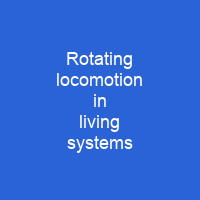There are two known examples of molecular-scale rotating structures used by living cells. The only known biological system capable of providing continuous propulsive torque is the corkscrew-like flagellum. Some organisms use rolling as a means of locomoting, as the organism rotates as a whole. Other species adopt more spherical postures, primarily to protect their bodies from predators.
About Rotating locomotion in living systems in brief

Other species adopt more spherical postures, primarily to protect their bodies from predators. This posture has been seen in pangolins, wheel spiders, hedgehogs, armadillos, Armadillo girdled lizards, isopods, and fossilized trilobites. Tumbleweeds, which are the above-ground portions of certain plants, separate from their root structure and roll in the wind to distribute their seeds. The most well-known of these include Kali tragus, or prickly Russian thistle, which arrived in North America in the late 19th century, and gained a reputation as a noxious weed. Fungi of the genus Bovista are known to use the same strategy to disperse their spores. The behavior of these beetles was noted in ancient Egyptian culture, which imparted sacred significance to their activities. Although it is the dung ball that rolls rather than the beetle itself, the beetles face many of the same mechanical difficulties that rolling organisms contend with. These species may roll passively or actively, typically by altering their shape to generate a propulsive force. Some species of elongate organisms form their bodies into a loop to roll, including certain caterpillars, tiger beetle larvae, myriapods, mantis shrimp,. Armadillidiidae, and Mount Lyell salamanders. Other species have been observed to purposely roll away from predators, including some species of wheel spiders.
You want to know more about Rotating locomotion in living systems?
This page is based on the article Rotating locomotion in living systems published in Wikipedia (as of Nov. 06, 2020) and was automatically summarized using artificial intelligence.







